| Author |
Message |
Daniel Parry

|
 Posted: Sun 05 Jun, 2022 1:42 pm Post subject: Getting there on the project with some help Posted: Sun 05 Jun, 2022 1:42 pm Post subject: Getting there on the project with some help |
 |
|
An interesting c1630 English rapier with detailed silver inlay work. Medium weight. Blade 42 inches and high quality.
 Attachment: 88.65 KB Attachment: 88.65 KB
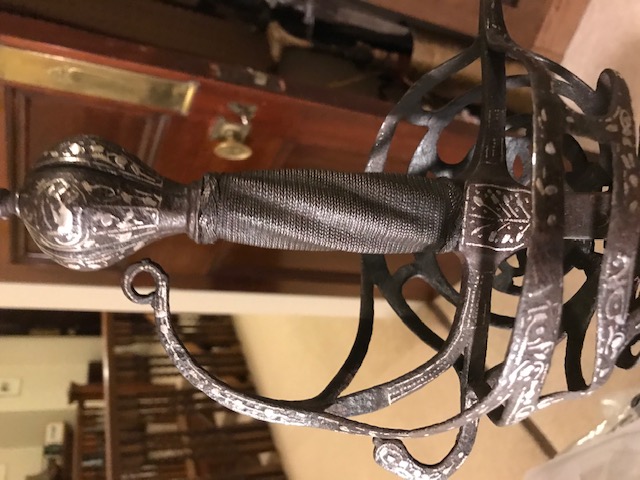
 Attachment: 67.54 KB Attachment: 67.54 KB
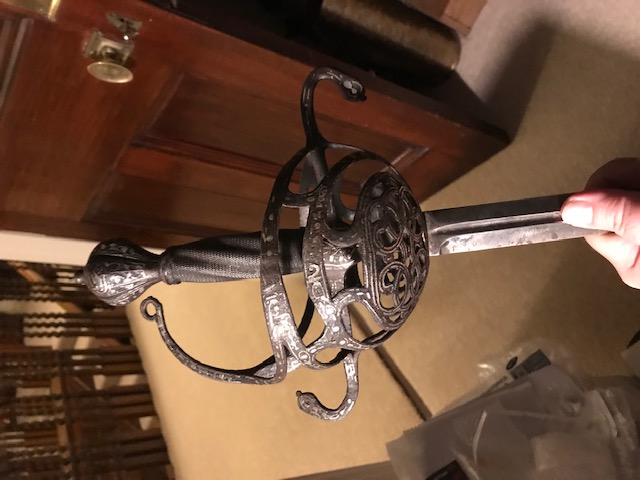
|
|
  |
 |
Daniel Parry

|
 Posted: Sun 05 Jun, 2022 1:53 pm Post subject: Posted: Sun 05 Jun, 2022 1:53 pm Post subject: |
 |
|
Unusually long probably Italian (certain traits look English but the massively wide dish and short quillons and decorative style make me thing maybe not.) duelling rapier, early to mid 17th century. Dish is huge but very finely executed with spiral ridges, interspersed with fine curved lines of dots.
Pommel very fine.
Blade of excellent temper and 51 inches long from the top of the guard. I thought this would be the longest rapier I could post here were it not for the one I acquired next.
 Attachment: 117.42 KB Attachment: 117.42 KB
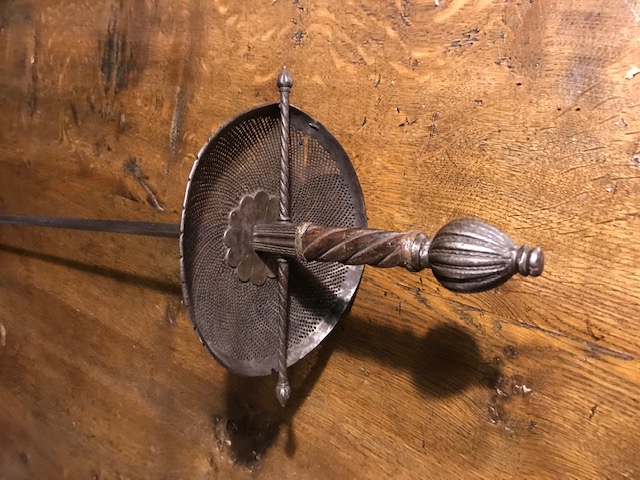
 Attachment: 108.08 KB Attachment: 108.08 KB
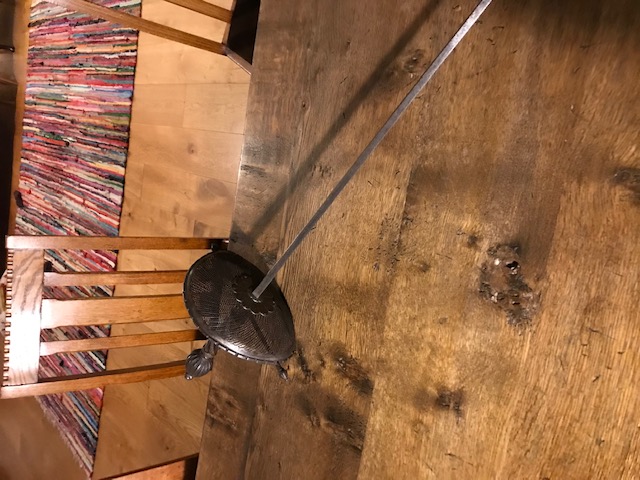
 Attachment: 92.46 KB Attachment: 92.46 KB
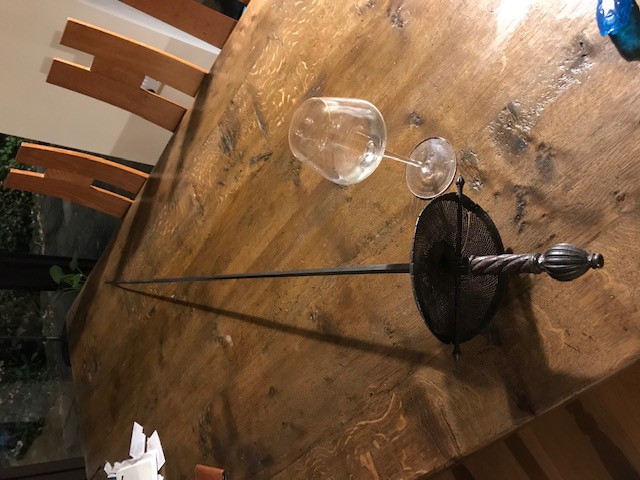
|
|
  |
 |
Daniel Parry

|
 Posted: Sun 05 Jun, 2022 2:10 pm Post subject: Posted: Sun 05 Jun, 2022 2:10 pm Post subject: |
 |
|
A good shorter military rapier, sometimes described as a Musketeer rapier. I have the example illustrated in the the 'Price Guide' and this is a a close cousin in terms of length and overall weight except this one has much finer hilt decoration and a finely pierced blade. It is also one of the early examples of the Colichemarde type blade as the forte is wide and strong hexagonal section but the blade then narrows to a thick but narrow hexagonal section blade with a clear step change at the forte. Interesting sword. It still has the leather wrap around the grip wire intact which is unusual.
 Attachment: 57.11 KB Attachment: 57.11 KB
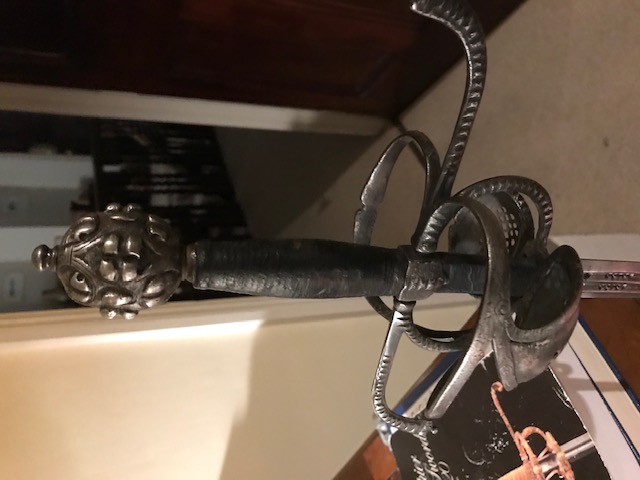
 Attachment: 55.61 KB Attachment: 55.61 KB
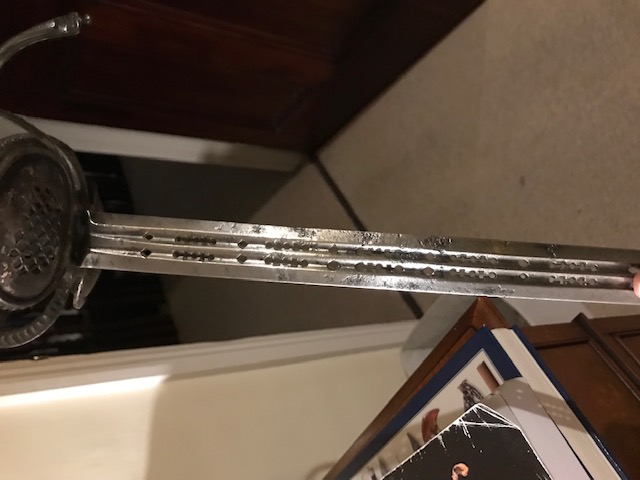
 Attachment: 57.56 KB Attachment: 57.56 KB
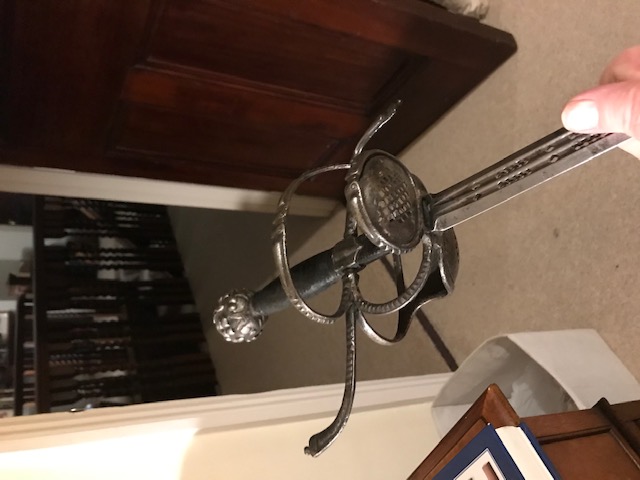
|
|
  |
 |
Daniel Parry

|
 Posted: Sun 05 Jun, 2022 2:27 pm Post subject: Posted: Sun 05 Jun, 2022 2:27 pm Post subject: |
 |
|
A very fine mesh guard dish hilt c 1650-1670. I suspect French. It's always difficult to identify French rapiers. The blade is short at 34 inches. It has a clearly razor sharp edge throughout and enough stiffness in the forte to be a good thrusting blade. Similar in handling to the better (i.e. not insanely long and floppy- bladed) transitional rapiers. As light as an early smallsword. Weight has clearly been minimalized in the design through the thin mesh guard and light weight quillons, pas d'ane and knucklebow.
 Attachment: 64.14 KB Attachment: 64.14 KB
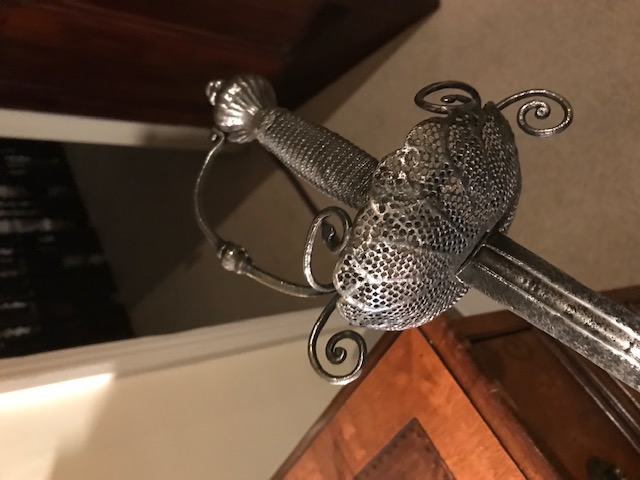
 Attachment: 51 KB Attachment: 51 KB
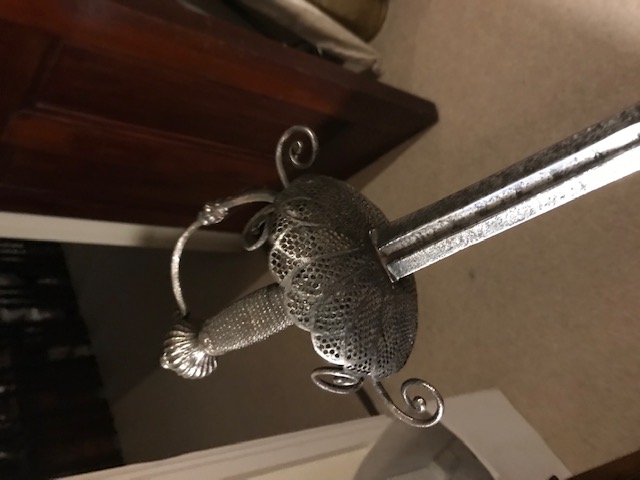
|
|
  |
 |
Daniel Parry

|
 Posted: Sun 05 Jun, 2022 2:49 pm Post subject: Posted: Sun 05 Jun, 2022 2:49 pm Post subject: |
 |
|
Interesting matched pair, first half of 17th century I think and possibly Flemish, though not sure. Sword is a well balanced cut and thrust sword, more akin to a lot of 16th century rapier/swords than 17th century. Dagger is a very well balanced 11 inch blade. Corrosion level is different to some degree between the dagger blade and the sword blade but don't see any obvious evidence of replacement or alteration.
 Attachment: 52.96 KB Attachment: 52.96 KB
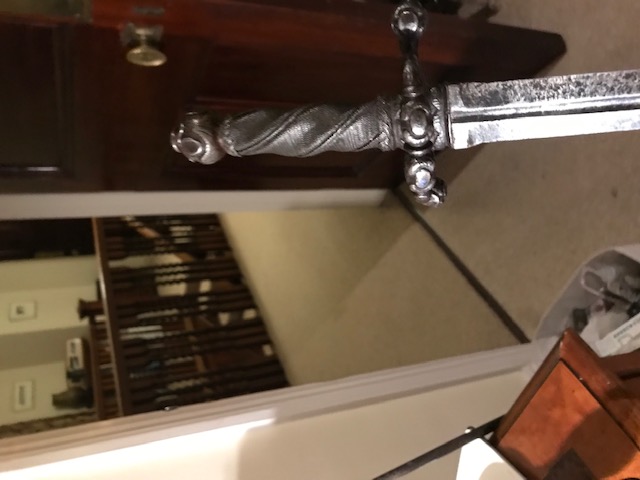
 Attachment: 60.12 KB Attachment: 60.12 KB
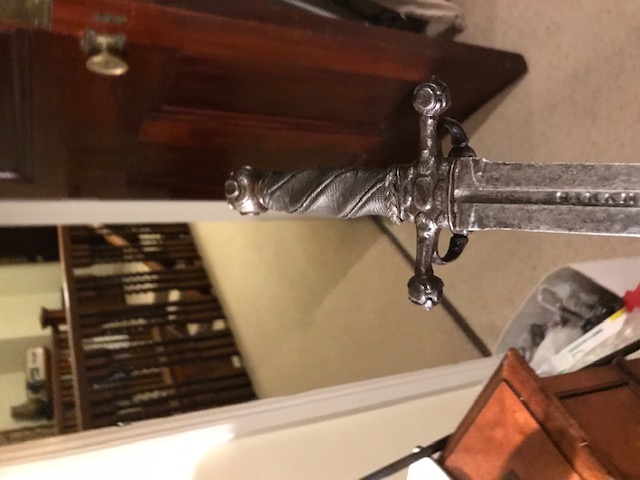
 Attachment: 63.1 KB Attachment: 63.1 KB
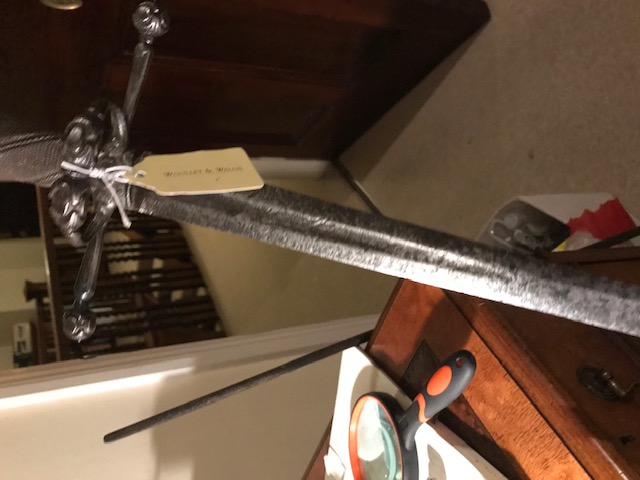
 Attachment: 61.56 KB Attachment: 61.56 KB
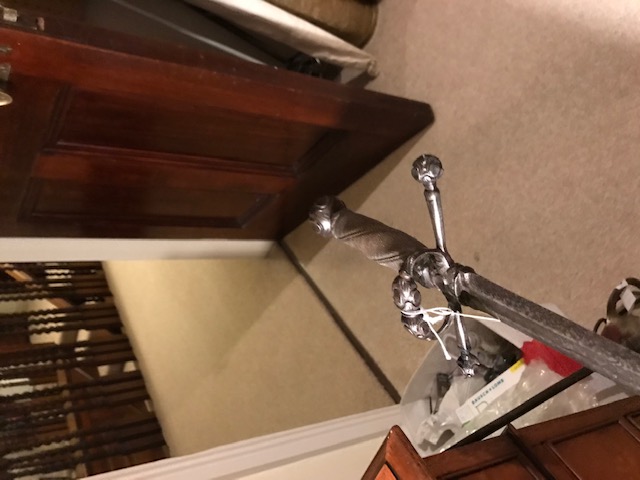
|
|
  |
 |
|
Sean Manning
|
 Posted: Sat 21 Jan, 2023 11:01 am Post subject: Posted: Sat 21 Jan, 2023 11:01 am Post subject: |
 |
|
Hi Daniel, how are those measurements coming along? A small set for half a dozen weapons which you actually publish would be useful for many rapier fans.
Edit: the pair with a single side ring are a interesting reminder that not everyone wanted very thorough hand protection (we see the same in the 18th century where there are smallsword hilts and stirrup hilts). How wide are the blades at the cross? I wonder if Sir John Smythe would have called them an arming sword and dagger.
www.bookandsword.com
Last edited by Sean Manning on Sun 22 Jan, 2023 4:00 pm; edited 1 time in total
|
|
  |
 |
|
Martin Buckley
Location: Wales, U.K. Joined: 23 Jul 2006
Posts: 128
|
 Posted: Sun 22 Jan, 2023 6:54 am Post subject: Posted: Sun 22 Jan, 2023 6:54 am Post subject: |
 |
|
|
Iíve seen many of these rapiers on antique sites over the years. Itís great to see them close up and in a different light, it really gives them an extra something. Compliments to those whoíve purchased them, I, for one, am phenomenally jealous.
|
|
  |
 |
Daniel Parry

|
 Posted: Wed 25 Jan, 2023 5:51 am Post subject: Posted: Wed 25 Jan, 2023 5:51 am Post subject: |
 |
|
Hi Sean and Martin
The blades are an inch wide at the cross. The sword is a general use cut and thrust blade, nicely balanced. Hard to date these forms sometimes as similar crop up in the 16th and 17th centuries (and the lighter sword with cross and side ring was around in the 15th century). Different I think to some of the mid-16th century swords which are looked at as early rapiers, where if you squint at them and remove the side rings and the simple hilt bars in your mind's eye, they are basically estocs in a lot cases, with a less generalised blade profile.
As for the rapier measurements, I have finally got off my lazy arse over the Christmas period and am nearly finished. I have done 40 rapiers from c. 1580 to 1680 to show the change in style and form. I want to run the results past a couple of other collectors and enthusiasts I know to see if they see anomalies or things which need adding in. It took a while as the measurements need to be seen in the context of the style as well the date, as a duelling rapier from 1630 will not have the same physical characteristics as a Pappenheimer from 1630.
This also leads into different blade profiles being suitable for different rapiers according to use not just period.
So I am filling out comments areas as much as I can without it being too wordy as doing it on Excel. I will put them in date order but if I put 'cuphilt' or 'swept-hilt' in one column and 'duelling' or 'general' in another and country (by hilt style and blade-maker where I can as they are often different) in another, people can search and re-arrange.
You really need 200 or so for statistical results but it might be interesting for people and comparable with other results from elsewhere. I also need to extend my blade profile categories !
I am away in the US for work for a few weeks then when back I will do the last few and post it. It has purely been that getting started thing - laziness - once underway with all the measuring stuff out I got into it !
|
|
  |
 |
Daniel Parry

|
 Posted: Thu 26 Jan, 2023 3:14 am Post subject: Posted: Thu 26 Jan, 2023 3:14 am Post subject: |
 |
|
Spanish cup-hilt c1660-1670
One of the light weight cup-hilts that emerged as northern Europe was moving towards transitional rapiers and early proto-smallswords but Spain kept its love of the cup-hilt. Super light and agile. Interesting pierced quillons and knucklebow. Hollow pommel.
Blade is marked Sebastian Hernandez (the younger) and the mark on the ricasso matches the mark for him in Kinman, although the dates for him in Kinman are a bit earlier (families used marks across generations and didn't always use a new name or mark for each generation). Blade is an interesting profile, a sort of proto-colichemarde with a wide forte narrowing to a 4 sided hollow ground blade for the remainder. Allows for a very light blade with sufficient strength in a similar way to later triangle hollow ground smallsword blades. I picked up an English dish-hilt rapier c 1650 which also has a similar 4 sided hollow ground blade - again light but strong.
 Attachment: 132.73 KB Attachment: 132.73 KB
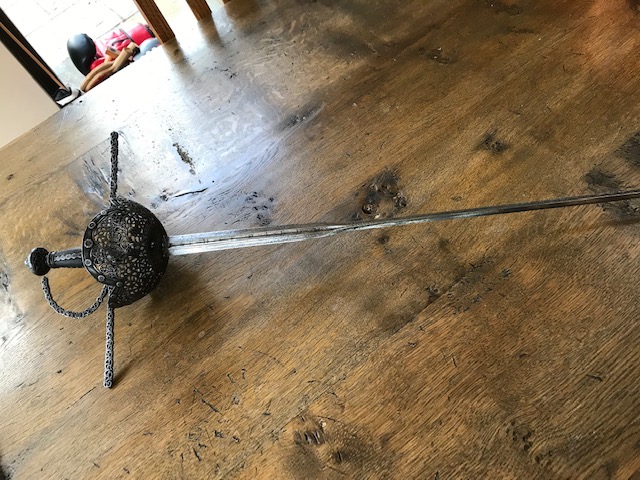
 Attachment: 150.25 KB Attachment: 150.25 KB
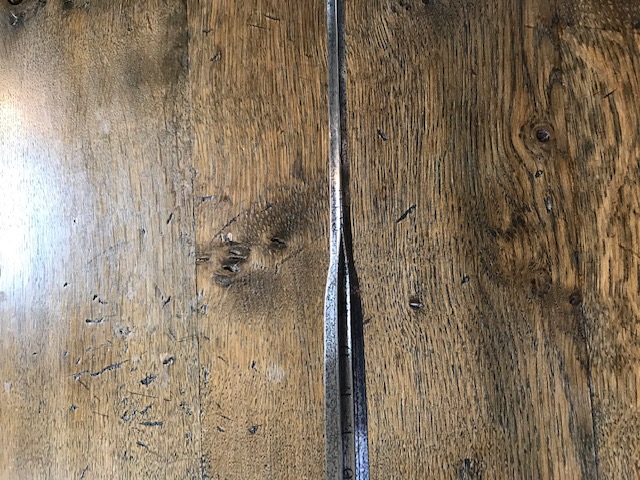
 Attachment: 147.81 KB Attachment: 147.81 KB
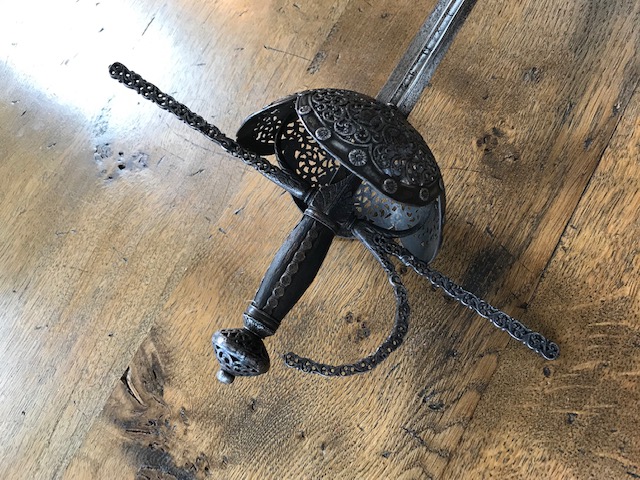
|
|
  |
 |
Daniel Parry

|
 Posted: Thu 26 Jan, 2023 3:45 am Post subject: Posted: Thu 26 Jan, 2023 3:45 am Post subject: |
 |
|
English dish-hilt rapier c1650.
This, like the one above, has a 4 sided hollow ground blade. The forte is different to the cup-hilt above and is a narrower, thicker forte with a deep i-beam type fuller as opposed to the wider and flatter/thinner forte on the cup-hilt which then narrows into the hollow ground blade. But they both achieve the same thing I think - a strong but light blade which is relatively hilt weighted.
Has the classic mortuary hilt style of grotesque faces (12 different ones - you get your money's worth) of that short period which helps to date it. Medium weight for the period but agile as it is hilt-weighted.
Blade marked Hermann Keisser of Solingen, 1625-1660 according to Kinman. Both hilt and blade have quality. The edges of the hollow ground blade are still quite sharp - you would cut your finger if you ran it up the edge with any speed or pressure.
 Attachment: 146.98 KB Attachment: 146.98 KB
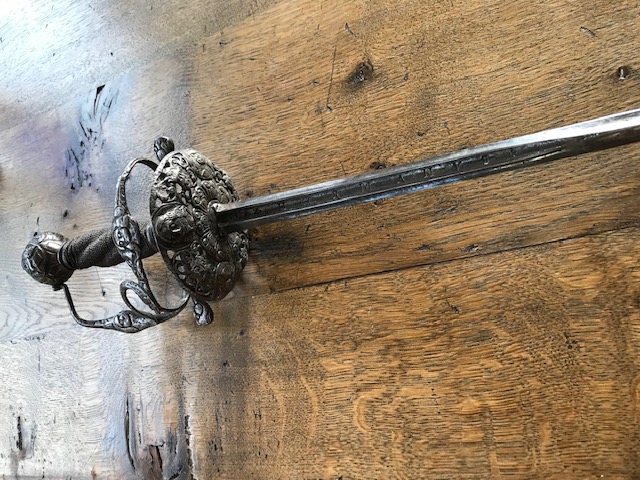
 Attachment: 152.63 KB Attachment: 152.63 KB
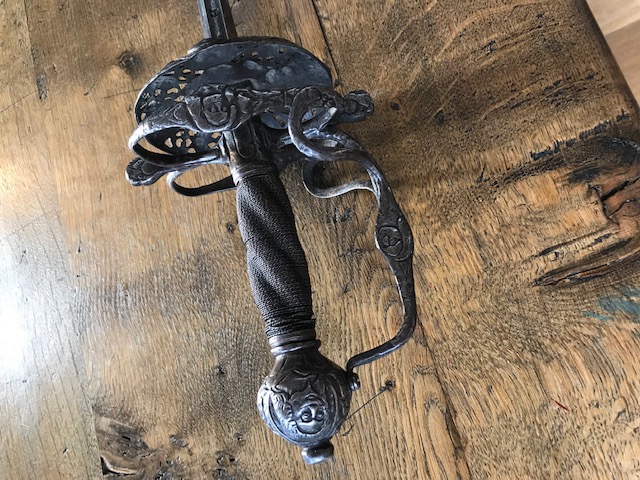
 Attachment: 177.03 KB Attachment: 177.03 KB
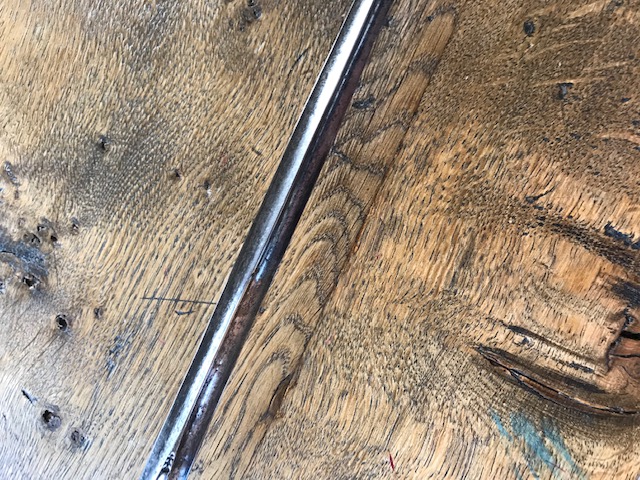
 Attachment: 102.01 KB Attachment: 102.01 KB
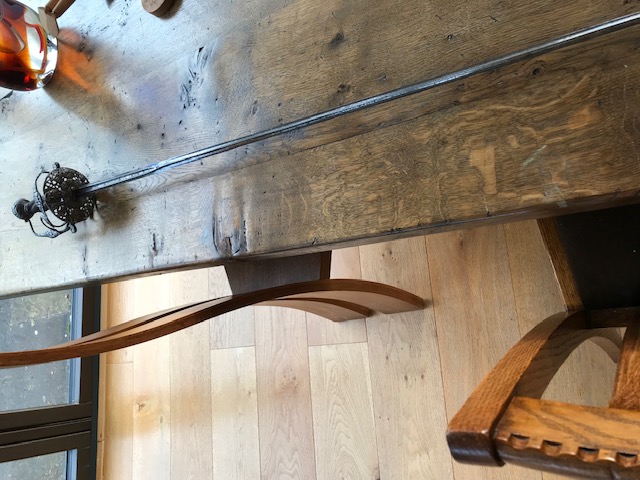
|
|
  |
 |
Daniel Parry

|
 Posted: Thu 26 Jan, 2023 5:49 am Post subject: Posted: Thu 26 Jan, 2023 5:49 am Post subject: |
 |
|
Just to link back to the point from Sean about the side ring sword and dagger above, I think the sword is an early form of Northern European 'pillow sword' https://www.clevelandart.org/art/1916.1495. These vary in size and substance but the style matches and the blade form does too except the later 17th century ones generally had smaller hilt bars and crosses and lighter blades.
This one is a bit more substantial and has the matching dagger, which I think puts it outside the later and lighter pillow sword group as daggers as a set with swords had pretty much died out by the 1680s. Pillow swords with this hilt style were around from the early 1600s and I think this is an early example and in a period when daggers were still a common accessory with a sword, hence the matched hilts. The dagger is a fighting weapon by its size and length I think. It isn't a general use knife/dagger or a sneaky back of your belt type of dagger.
That's my guess anyway. Some aspects made me think they were 16th century - the blade on the sword for instance - but my gut feel is early 17th. Could be an older blade remounted possibly. Also the hilt is a bit too baroque for the 1500s I think.
They are a nice set - compact but quite substantial weapons in mass. The sword would serve as a good cut and thrust weapon. It is in a way like a mini-arming sword in feel, per your point.
It's interesting that I have seen some people associate pillow swords with the development of smallswords. I don't agree with this and think that view is driven by the fact pillow swords were shorter than rapiers and so they associate them with the trend for shorter and lighter swords as fencing styles changed. But the ones I have handled (not that many to be fair so anyone shout if they disagree) are compact but quite robust and have weight in the way the early smallswords do not because of their purpose. I think the smallsword developed entirely from the light weight transitional rapiers of the second half of the 17th century which got lighter and shorter as the century went on. I have quite a few from that period showing the development. I will post a good early example from about 1660. I think pillow swords were a different group personally but happy if others disagree
|
|
  |
 |
|
Sean Manning
|
 Posted: Mon 15 Jan, 2024 9:49 pm Post subject: Posted: Mon 15 Jan, 2024 9:49 pm Post subject: |
 |
|
How are those measurements coming along Daniel? If you measure one sword when you get up on Saturday mornings you will be done the collection by spring.
It looks like it was Marco Danelli back in 2015 who said
| Quote: |
(The article by Fortner and Schrattenecker) sums up everything I try to do with custom orders, with fewer budget restrictions, to get closer to the originals, like using blades starting at 8mm on the forte and a geometry that has a much stronger forte, but often the reply I get is "it is a bit heavy". |
www.bookandsword.com
|
|
  |
 |
|
|

